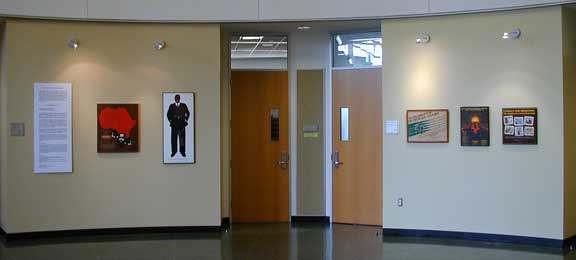Poster exhibit:
Works by
Lincoln Cushing
Rotunda Gallery, University of
San Francisco School of Law,
2130 Fulton (at Parker Street)
March 7-July 22, 2008


Artist’s statement
View complete
catalog of all work 1969-present
“The artist elects to fight for freedom or
slavery.
I have made my choice! I had no alternative!”
-Paul Robeson, Manifesto against Fascism, 1938
The work on these walls represents the union of
several distinct genres of art, representing deliberate choices on my
part. All are printed duplicates, because I like to be able
to give away copies of my art. Most are posters, a specific
type of print intended for public display rather than private
consumption. And all are explicitly or subtly political –
because I have chosen, as did Paul Robeson, to apply my artistic skills
for social change.
I started making these as a high school student living in Washington,
D.C. during the turbulent 1960s. Inspired by the prints of Sister Mary
Corita, a couple of friends and I apprenticed ourselves to Lou Stovall,
a local printmaker, and began to learn screenprinting. I decided early
on to not try to make a living as an artist, but rather to use my
artistic output as a tool for projects of my choice. I continued to
make silkscreen posters when I moved to San Diego to go to college, and
in 1982 I came to Oakland where I worked with the community resource
Inkworks Press and continued to make screenprints on the side.
My current work with these materials involves their documentation and
analysis rather than their production. Political posters receive very
little academic attention in this country, and there is a huge void in
scholarship. I have devoted much of my creative effort to advancing the
visibility of these posters and encouraging greater pedagogical use of
them.
I am often asked if the Web has replaced the need for posters as a
propaganda medium. I believe that posters – big sheets of paper with a
message – still have a place in this world, although the historical
evidence is that their popularity rises and falls over time. A cool
YouTube snip will have its moment, but that poster you put up in the
window about the U.S. troops getting out of [insert country of your
choice here] will stick around for years.
Technical notes
The screenprints and offset prints here are of sufficient vintage that
they were produced with “old school” techniques that bear mentioning.
The screenprints, with few exceptions, were made with direct stencils,
meaning that sheets of emulsion on mylar backing were cut by hand and
then adhered to the screen with lacquer thinner (later on I was able to
substitute water-based stencils). All inks were oil-based. Similarly,
the offset posters designed before 1996 were produced with technologies
now totally transformed by computers. The lettering were sent out to a
typesetter and then pasted up; the photos were sized, shot as film
halftones, and then stripped onto flats for plate burning. The fields
of color were cut on rubylith and stripped in.
Bibliography
Revolucion! Cuban
Poster Art, Chronicle Books, 2003 (author)
Visions
of Peace & Justice: 30 years of political posters from the
archives of Inkworks Press, 2007 (editor)
Chinese
Posters: Art from the Great Proletarian Cultural Revolution,
Chronicle Books, 2007 (co-author)
Art/Works
- American Labor Posters, Cornell University Press, expected 2009
(co-author)
Lincoln Cushing
Docs Populi – Documents for the Public
https://www.docspopuli.org


![Survival [play], 1979; Working Committee on Southern Africa; Grass Roots Events; screenprint 26.5x27.5 Survival [play], 1979; Working Committee on Southern Africa; Grass Roots Events; screenprint 26.5x27.5](../images/USF_thumbnails/1028.jpg)








![Music for peace and liberation 'Con-Fest' 1984; [CPUSA] offset 20.5x15 Music for peace and liberation 'Con-Fest' 1984; [CPUSA], offset 20.5x15](../images/USF_thumbnails/1133.jpg)



